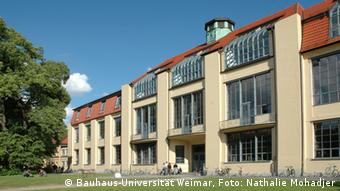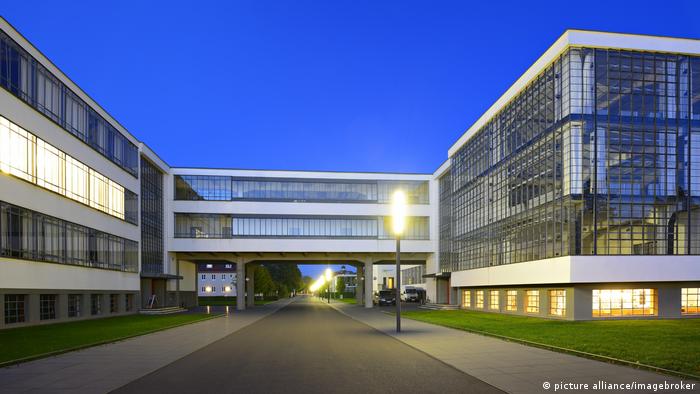The Bauhaus buildings in Weimar and Dessau are monuments, but by no means relics of a bygone time. In them today is taught and researched. In the spirit of the Bauhaus pioneers, only with fresh ideas.

If the children are not obeyed in the 1920s in Weimar, then it was: “If you’re not good, then you come to the Bauhaus.” There, at the art school, the “Crazy”, and danced in colourful theatrical costumes and noisily through the streets and pictures with triangles, circles and squares painted rates lived.
Today, students come from all over the world to study at the successor institution, the Bauhaus-University in Weimar. With approximately 4080 students from 70 countries it is one of the most international universities in Germany. Since 1996, the Bauhaus sites in Weimar and Dessau world heritage site. It attracts tourists and students alike.
The idea of interdisciplinary Work

The old workshop building of the art school of the Bauhaus
Workshops for painting, furniture, weaving, or metal, it is no longer in the historic and new buildings of the Bauhaus-University. Under the founding Director, Walter Gropius, artists and craftsmen should work together and learn from each other. Today, the University offers faculties of architecture and urbanism, art and design, civil engineering and media.
The idea that students can work in individual modules, and projects across the faculties, lives on, particularly in this anniversary year, as Nathalie Singer, Professor for experimental Radio and Vice-President of the Bauhaus University explains: “In my group, one of the audio walk, for example, in the case of the media, designers and people from the Audio sector, working together with conservators from the world of architecture. The preservation generate the content of 100 years of Bauhaus, which are then implemented by the media people in the audio walk.”
The Interplay of art and technology
At the beginning of the 1920s, the Bauhaus worked on the Design closely with the industry. The Bauhaus designed products with simple shapes that were easy to handle. Walter Gropius wanted that art and technology form a new unit. Products for industry, the Bauhaus University some more designs today, but she explores the meaning of new technologies for the company. For the anniversary of the Weimar University has announced it will be starting in October 2018, a Bauhaus semester. “We think about in lectures and colloquia, the ideas of that time, today, in our digital time or our questions of the relationship between man, nature, and technology transfer,” says Singer. “We are now, for example, before the great question, what makes the digitization of the Design but also with the society and their social behavior.”

Architecture students at the Bauhaus University to create for the anniversary year, the locations at which guests on the Bauhaus, can, here, still in draft
In the case of the civil engineers and architects, the topic of sustainability plays an important role. After the first world war, it was the members of the Bauhaus, first and foremost, to build a convenient and practical, to facilitate people’s mobility and work. Of sustainability and energy efficiency was no talk at that time. “These are issues that are more important today,” says Nathalie Singer. “By the researchers, the results of which are worn in the society. We have already registered patents, which then can be applied.”
Pilgrimage Bauhaus Dessau
In 1925, the “Crazy-had to move” from the Bauhaus because of the tense political situation of Weimar to Dessau. There, architect Walter Gropius designed a building that impresses with its continuous glass facade. The world heritage site is today regarded as an icon of Modernism.
The Turkish architecture-PhD candidate, Eci Isbilen’s come all the way from the USA from the Polytechnical State University in Virginia, to join a Lab at the Bauhaus Academy in Dessau. The Bauhaus is today a popular destination for architectural pilgrims, said she, even if the construction would correspond to long-today’s building codes. “You have to experience this place longer,” says Isbilen, then you get to know the benefits. “The large window fit to this place. You can open it on both sides. It is pleasant to work, when it is hot outside. The building is so in another sense, efficient.”

The Bauhaus Dessau, icon of the Modern
Research on own object
The Academy, which belongs to the Bauhaus Foundation, Dessau, Germany, offers not only Labs, but also one-year master programs in cooperation with the Anhalt University of applied Sciences and Berlin’s Humboldt University. Already at the times of the GDR, the Bauhaus opened in Dessau as a mixture of cultural and research institution. Founded in 1994, the Foundation has continued this approach.
For a long time, there were workshops at the Bauhaus Dessau. It was also a social in the Region, and brought up in the 2000s in urban development projects. In recent times it has been explained, this focus is shifting to the curatorial work, Regina Bittner, head of the Academy. “With the Bauhaus buildings and the new Museum in the anniversary year of opening, we try from the legacies of the Bauhaus references to the present, and objects from the Museum’s own collection in the design science.”
The globalization changes the view to the Bauhaus history

Regine Bittner at the Symposium “Between Chairs. Dialogues on Design and craft”
Take a concrete object, which have a conversion story, such as the Desk or the chair of a Bauhaus designer. These objects would then be examined in the context of parallel developments. “We want to throw for the anniversary in today’s globalization, a different view of the Bauhaus. It’s no longer about to see the Bauhaus history and its influences on the world,” explains Bittner. The Bauhaus’m going to explore in the context of a cultural Modernity, there is a fertile exchange between the regions of the world.
Regina Bittner remembers a visiting student from Colombia, has worked with the textiles of the Bauhaus artist Anni Albers. “She has linked with the question of the extent to which the new interest in the craft tradition of the Andes in the case of young Colombian designers is the link to the Dialog, the Anni Albers in the 40s and 50s. So what can we learn in today’s life of the Andean craft traditions?”
The Fascination Of The Bauhaus

At the opening of the Bauhaus Lab to Ludwig Konrad wachsmann
Eci Isbilen has specialised in standardised building systems and mass production. Her doctoral thesis, she writes about the architect Konrad Ludwig Wachsmann, who has driven in the 40s and 50s with Walter Gropius in the United States, the industrialization of building. Guard has developed a universal construction system with industrially prefabricated components. Its construction was the topic of the Labs in 2018 in Dessau. “It pays to be in this context, because you cannot wax consider man only as an American phenomenon,” says Isbilen. “It is one of the stories that started here, across the Atlantic went down and then here came back. To switch the places, helps to change the perspectives.”
The ideas and products of the Bauhaus school are currently in high demand, not only the anniversary in 2019, says the head of the Academy, Regine Bittner. It was the realization that we have to deal with in a globalized world, natural resources, and not more and can produce, consume, as before. “A crisis experience in the 1920s. At the time, the Bauhaus students have been looking for solutions on how to get to and in the process of industrialization changes in the presence of all, and this human can make.” The optimism of the Bauhaus pioneers have tried to make their presence human, have a role model character. Therefore, Bittner says, to look again today with a fresh look at the Bauhaus.